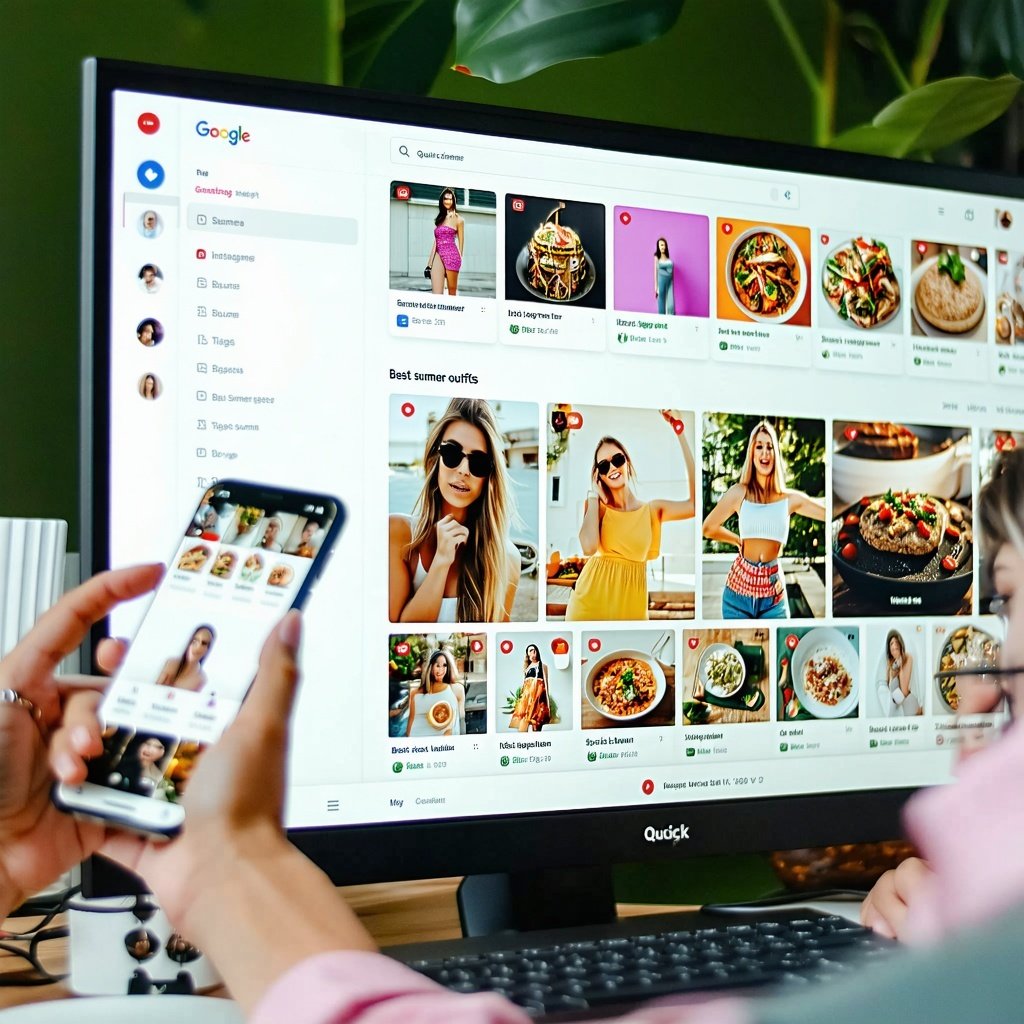Winning in the Age of AI Search: How Brands Can Thrive as Search Evolves
Search is changing faster than ever. With the rise of AI-powered features like Google’s AI Overviews and AI Mode, the familiar “10 blue links” are...
Read moreLast month we spoke to Alison Humphries about our international marketing capabilities and why it is so important to keep tight control over your in-country presence. Next, it’s time to catch-up with Senior Content Specialist, Alice Murray, to find out how to make the most of your content resources.
Before I spent 100% of my time delivering client content strategies, whereas now I'd say it's probably about 60/40. It’s still the case that 60% of what I'm doing now involves creating content, planning content calendars, and developing other assets, but the other 40% is now spent managing and progressing the development of the content team. I work really closely with Tom Williams the Head of SEO, and Jade Coleman our Client Operations Director to drive improvements within the SEO team and work on new products and services to make us even more creative.
SEO is a massive part of what we do. Nothing that we propose to clients is done without a huge element of SEO - everything that we do, whether it's on-page optimisation, a blog post or any kind of creative asset, is the result of an SEO strategy. The content team do a lot of research using tools such as BrightEdge, Moz, SEMrush and Google Analytics, but we use them from a content perspective. That means looking at landing pages, keywords, and even page speeds. The user journey is a massive thing for us, looking at how we can convert users into buyers. Part of that is keyword URL mapping - making sure that we know which page we want to perform for different search terms. This forms part of the final content plan, which is also when creative asset planning come in.
My objective is for the whole content team to be more creative and to move outside of their comfort zone. Today, I’d say that blog posts are only 10% of what the content team does. So, we might create an infographic to accompany a blog post, which makes it more visual and much more shareable on social media. Or we might develop an eBook, which is an evergreen downloadable asset that clients can use annually to support an event, for example. We can also produce video and image assets, and we’re now including a minimum of one media asset per month for every client.
This is a massive strength of ClickThrough. Only half of our time is spent writing content. Preparation is vital, and that’s all about the numbers. Each member of the team looks at data every single day, without fail. That's why content lives under the umbrella of SEO and not just a standalone content department - SEO and the data behind SEO is a massive driver for what we do every single day.
I’ve only seen positive changes from it. We've also had good feedback from clients who feel our specialist teams can be a lot more focused now, and they know exactly who to go to.
The content team have been able to get to know other departments in the business a little bit more, with more visibility on the media side of the business, and that can only be a good thing.
Most agencies will offer content writing, but where so many go wrong is that they fail to consider SEO. Optimisation is not just about correcting grammar or expanding content - it's looking at internal linking, meta data, image placement, alt tags, and ensuring that the page template is going to deliver the user journey that we're trying to achieve for the client.
I’m part of a highly versatile content team. We all have our own specialisms, because of the breadth of experience in working with different clients. You’ll also have the same content lead on your account from start to finish, which means your brand will not be passed around from person to person. Your tone of voice will never be lost, and they'll know your competitors and objectives inside out.
Added to that are the assets that we can provide - whether that's a visual asset, or a data-driven asset such as a graph. Being able to boost our content further is a huge differentiator. I think it’s important to encourage clients to be a little bit more adventurous in their content strategies and to try to stay away from the norm. It’s the only way to compete, especially if you're in a highly competitive market. You need to stand out, and you need assets at fingertips to allow you to do that.
What's important with content is that there are no right or wrong answers. You're not working with numbers; you're working with someone's creative ability. The numbers follow the work. I know this sounds a bit cheesy, but our content team are just extremely passionate about what they do. I think that it sets us apart. We look to hire people based on their personality and values, and not just their experience. When you put someone in this role they have to be creative every day, while also having the resilience to deliver. And this isn't just in the background - it's also in client meetings, and it's hard to get that combination just right.
Most clients have data-led objectives - KPIs or numbers they need to hit, usually based around visibility or profit. So our job is to generate content that we know will lead us to that result.
In terms of challenges, moving into new markets comes up a lot. For example, many of our clients are looking beyond the UK market to Germany, France, Italy, and beyond. Also, almost every content client has launched on Amazon since I've been working here. The Amazon service that we offer is well aligned with SEO, Content and Digital Paid Media.
We're also seeing a lot more need for integration. That plays to our strengths. ClickThrough is such a close-knit group. We're not an 800-person company where employees don't even know each other's names, which a lot of agencies are. Because we all know each other on a personal level we have much more success.
As early as possible. If a client is running a content campaign, the content lead will be on the initial kickoff call. The benefits are that you have someone who has had visibility on everything from start to finish, and who can then align the content plan and copy to the original objectives.
Everything we write must have a purpose, and link back to an objective. Say, for example, we’re working on a Black Friday campaign where a retailer wants a 35% uplift in sales. We’ll ask ‘what was the content like last year? How can we improve it this year? What's going to drive users to buy?’ That's when we'll look at bringing in help from other departments.
How we start with a client depends on where they're at. Nine times out of ten, and especially if a client doesn’t have much content on their site, we’d start with a keyword research database first and foremost, because it exposes the current SEO gaps and opportunities in comparison to their competitors. It goes hand-in-hand with a technical SEO audit. Those two projects then flow into a content plan, based on where we think the biggest opportunities are. It all depends on what the client wants.
It can take six months of optimisation before we get to the more creative stuff, so the clients that we've had for a long time are those we can do the most creative work for. The initial work gets them where they want to be in terms of their website and content quality, and then after that we're shooting further for conversions.
One way we get to know a business is to go to the client’s premises, meet the whole team and immerse yourself in their business. You’ll always come back with a load of ideas to fuel a content plan.
Recently I took my laptop and sat in a client’s showroom. I was working on a landing page, and just seeing products on their website wasn't doing it for me. I knew I needed to get a real feel for these products and what they bring to the user. So I went to the client, sat in their office, had a tour around and I was in a much better position to write about their products and create a content strategy around what I had learned.
Another client operates in the property market. The content team and account managers went to one of their estate sites in London, hard hats and all, to better understand their estate. We’ve even had people attend jewellery making workshops to see things from the target audience's’ point of view.
Examples like that show that we go above and beyond to really understand what we are selling and what their demographic find most interesting. In each instance, making that effort gave us a real sense of what we needed to write about. The ability to switch seamlessly from a topic that's quite challenging, such as funeral planning, to writing about cocktails - that's something the team here has in abundance.
We have target personas for every client. That's something that we address early on. In our kickoff call with a client we get to grips with their audience demographics. We can also understand a lot from Google Analytics - who is clicking onto landing pages, what their other interests are, and the market buying personas of the users that are going on to your site. If you're going to be writing on behalf of a client day-in day-out, you really need to understand what they sell and what they want their audiences to buy into.
Tone of voice is also huge, and we've run data-led tone of voice experiments in the past, using user feedback to find just the right tone to represent your business. One way to do that is to use a competitor’s tone of voice on your website, get some testing done, and see which comes out on top. This can open up some great conversations with our clients as we work to develop a unique tone, and keep it in line with what people really want to see on their website. Understanding the persona allows you to nail the tone of voice, which is makes everything else easier.
When lockdown started, the content team discussed how COVID-19 would affect each client and their customers. It was a major change, but even in more normal times trends and events change things constantly.
Absolutely. The team recently created an eBook for a client about retirement travel. We had learned that the over-50s market was the client’s most loyal customer base, and we wanted to encourage further repeat bookings. It became a popular downloadable asset for them and generated a lot of visibility on their site. And because the eBook was so in-depth, the client could take snippets from it and share them with their audience on social media, use parts of the content on landing pages, and incorporate it into relevant blogs. That ended up forming the basis of a whole retirement campaign.
I see us working more on organic social for clients. We recently helped a client embrace Pinterest. In three months, they went from not having a Pinterest account to it being one of their top five referring domains. That’s a big deal.
Doubling-down on your social efforts is something that I recommend for any client. Everything that you publish on your site should also be shared on your social media channels – even today not enough companies are doing that.
If you’re talking about multimedia, quite possibly. If I search for something, I want a quick answer. If a 10-minute video pops up instead, that's my biggest bug bear. I want either a 30-second video or a quick written answer from the universal results on Google.
It depends on what I'm searching for. However, you can't get into the universal search results in Google without a very thought-out content and SEO strategy, which means you're not going to reach the universal results or get the visibility or the traffic you want from only running with thin content on site. Strong, core content acts as the foundation that allows everything else to work.
Do you have questions on how you can make your content marketing strategy successful? We’ve got the answers.
More articles you might be interested in:

Search is changing faster than ever. With the rise of AI-powered features like Google’s AI Overviews and AI Mode, the familiar “10 blue links” are...
Read more


The latest version of our newsletter should have settled in your email inbox, detailing the need-to-know information and must-read thought leadership...
Read more
Arming yourself with the right tools to ensure a smooth site migration is important - find out how to protect your SEO during a migration today.
Read more
As the cost of living continues to present challenges for many Brits, an increasing number of families are choosing to holiday within the United...
Read more
Our first curated newsletter has hit inboxes, detailing all of the latest need-to-know information and sharing all the necessary thought leadership...
Read more
Over the past few years, marketing leaders have been gearing up for the inevitable 'Cookieless Future'. Safari was the first to bid farewell to...
Read more